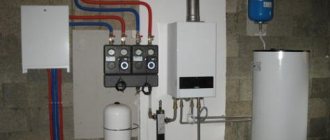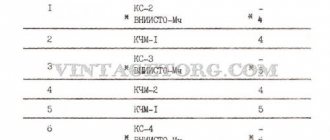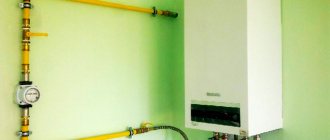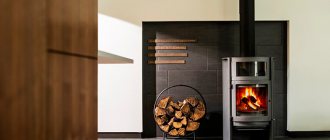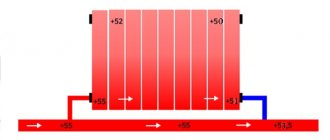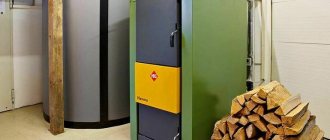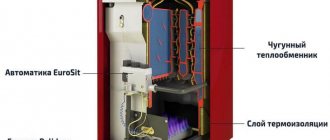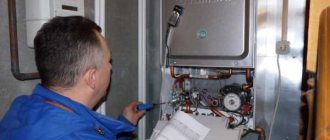Regardless of the effectiveness of the smoke removal and ventilation system in the boiler room, when solid fuel is added, soot escapes from the chamber and settles on the ceiling and walls. Outdoor wood boilers do not require installation in a special room. They can be installed in a place remote from residential premises, on the edge of the local area.
Types of outdoor wood boilers
Outdoor heating units are:
- solid fuel standard design;
- top combustion with a chamber in the form of a cylinder;
- pyrolysis with high-temperature splitting of firewood into highly flammable gases;
- long burning with a shaft to increase the volume of fuel storage;
- equipped with a screw feed of granulated or pressed raw materials.
Boiler design
Devices for heating rooms convert combustion energy into heat, while volatile substances are removed through the chimney. Structurally, the boiler is a wood-burning stove made of steel sheets.
To increase efficiency, the combustion chamber is covered with a double layer of metal plates. The sealed mediastinum, formed by the outer and inner iron casing, forms a water jacket, which is filled with coolant.
The boiler has fittings for connecting the supply and return pipelines.
The design consists of the following parts:
- housings made of steel sheets or cast iron elements;
- combustion chamber;
- grate;
- ash collection compartments;
- smoke exhaust duct;
- mediastinum filled with coolant (water jacket);
- an insulating layer to protect against atmospheric influences and prevent energy losses;
- devices for pumping air into the combustion chamber;
- circulation pump;
- control module.
Principle of operation
The coolant that fills the water jacket is heated by the energy of the burned fuel. Circulation pumps supply hot working fluid through an insulated underground pipeline into the house, where it is distributed to radiators. The cooled water returns to the boiler mediastinum for reheating.
As the fuel burns out, additional loading is carried out and the ash pan is cleaned.
Advantages and disadvantages
Outdoor units have a number of advantages:
- Reliable electronic module that controls the device. It supplies dosed air to the combustion chamber, monitors the temperature in the firebox and water circuit, and controls the intensity of the circulation pump.
- The large front door makes it easy to load firewood and clean the internal elements from soot and carbon deposits.
- The combustion chamber has the shape of a cylinder. The energy from the flame is distributed evenly in it, and intense gas and heat exchange occurs. This promotes fast and efficient heating of the water circuit. In the cylindrical chamber there are no areas of increased temperature exposure, as a result of which the walls of the boiler can deform and burn out.
- The outdoor heating unit is equipped with a lighting lantern for ease of maintenance at night.
- The chimney and boiler are reliably protected from atmospheric influences, thermal insulation is made of special materials.
The undeniable advantage of an outdoor boiler is the ability to effectively heat several separate rooms at the same time.
The disadvantages of such units include the need for:
- organizing a site for storing firewood;
- periodically filling the combustion chamber with fuel;
- scheduled cleaning of soot and soot.
Advantages of outdoor boilers
- Economical.
Outdoor heating boilers are designed for outdoor placement, allowing you to avoid spending money on the construction of a separate boiler room, and set optimal prices for heat and hot water for consumers. - Autonomy.
Outdoor gas boilers are equipped with an automation unit and remote control and can be used to create autonomous heating systems. During operation of the units, it is enough to monitor the main parameters on the remote control and carry out their maintenance. - Safety.
The models are equipped with an automation system that monitors the temperature and pressure of the coolant in the network. A system has also been installed to monitor increased concentrations of CO and CH4, which cuts off the gas supply in the event of a leak. - High efficiency (at least 95%).
In our company you can buy external gas boilers, insulated with modern heat-insulating materials, which ensure maximum fuel combustion and minimal heat loss. - Durability.
The boiler body is made of high-strength steel sheet with seamless metal pipes, ensuring a long service life. - Silence.
Thanks to the use of burners of reduced sizes, outdoor heating boilers operate almost silently, which is why they are used and installed near residential and administrative buildings.
Can I do it myself at home?
Outdoor boilers are massive and bulky devices. Their weight can reach a ton, and the volume of coolant contained by the water circuit is 400-700 liters. These units are made of special materials that can withstand prolonged high-temperature exposure, with minimal deformation.
High-density basalt fillers are used for thermal insulation of outdoor wood-burning boilers. In a home workshop, it is problematic to produce a device of such mass and dimensions. But despite this, with the proper level of mechanization and possession of the necessary skills, you can make a small outdoor boiler yourself.
Many manufacturers provide a lifetime warranty on their devices. This indicates the highest quality of materials used in the construction and the professional level of the workers.
How are they different from other equipment?
In terms of the method of obtaining energy for heating premises, outdoor boilers are similar to traditional ones. Their indisputable advantage is that there is no need to specially equip the room for installing the unit. This factor eliminates the risk of fire or other threats to people living in the house.
The absence of a boiler room will eliminate a number of measures related to ensuring safety, and in the case of installing a unit on natural gas, it will eliminate the design and expensive installation of pipes.
Prices: summary comparison table
Next, consider a comparative table of the cost of some external gas boilers of various modifications.
| Model | power, kWt | Price, thousand rubles |
| Phoenix-40 | 40 | 225 |
| Phoenix-60 | 60 | 235 |
| Phoenix-100 | 100 | 250 |
| Phoenix-200 | 200 | 365 |
| Phoenix-300 | 300 | 425 |
| Phoenix-400 | 400 | 490 |
| Phoenix-500 | 500 | 515 |
| RS-H-40 | 40 | 230 |
| RS-H-150 | 150 | 350 |
| RS-H-300 | 300 | 695 |
| RS-H-600 | 600 | 905 |
| RS-H-1000 | 1000 | 1100 |
Rating of the best outdoor wood-burning boilers for heating
The production of heating devices is carried out by manufacturers of various levels of equipment - from high-tech automated workshops to semi-handicraft firms. It is necessary to buy a home heating device from companies that have been on the market for a long time and have proven themselves well.
“Trayan TPG-15” (15 kW)
Single-circuit unit designed for use in forced and gravity heating systems. Capable of providing full heating of a house with an area of 100-130 m².
Kentatsu Furst Elegant-03
Non-volatile wood boiler from a Japanese brand. Cooled grates and a heat exchanger made of anti-corrosion cast iron are the key to a long service life. Operating time on one load is up to 4 hours.
“Teplov Universal TA-40” (40 kW)
Long-burning solid fuel unit for use in heating systems of industrial and residential facilities with a total area of up to 400 m². On the basic model, which does not require an electrical connection, an automatic control unit is installed if necessary. The device is unpretentious to fuel; it runs on wood, coal, and briquetted waste.
Zota Forta 12
The model is capable of heating an area of 100-120 m². When equipped with a bunker installation and a feeding auger, it can operate on granular fuel in automatic mode for several days.
Stropuva S30 (30 kW)
This powerful, non-volatile unit can easily handle heating a large home or commercial facility up to 300 m². The combustion chamber can be filled with any type of solid or granular fuel. The duration of work on one bookmark is from 1 day (with wood) to 2 (with pellets).
Wirbel Toby B Compact 12
A compact boiler from an Austrian brand that does not require an electrical connection. Single-circuit steel unit with a calculated heating area of 130-150 m². Production is licensed in Russia.
“Zota Topol-16VK” (16 kW)
The model with tubular water-filled grates has an increased level of heat transfer. The boiler is designed to heat rooms up to 160 m². Can operate on various types of solid fuel. The specially shaped chimney pipe eliminates blockages and burning of the walls.
Stropuva Mini S8 (8 kW)
A compact unit for efficient heating of small objects with an area of up to 80 m², has an environmental certificate. You can use coal, firewood, pellets or wood waste as fuel. The minimum burning time on one tab is a day. A large ash pan can be cleaned only 2-3 times a month. The vertical door makes loading fuel easy. Heating a dacha with a TT boiler would be the best option.
SAS UWT 14 (14 kW)
Steel solid fuel automated boiler, insulated with basalt wool, for use in closed and open heating circuits. A hot water supply boiler can be connected to the device. Designed for use as coal fuel. Heated area – 100-120 m².
Stropuva S40 (40 kW)
Powerful and reliable energy-independent long-burning boiler. Suitable for heating one or several closely spaced rooms with a total area of 400 m². The device provides equally high efficiency when operating on any type of solid fuel.
The best known manufacturers and models: characteristics and prices
Consumers whose budget for heating and hot water supply is not so limited should look for a super comfortable solution for China in products from German manufacturers. The middle price segment with a different set of options is occupied by products from other European or Asian countries. The Russian part of the market is also saturated with various options for outdoor gas boilers with almost any configuration at a significantly lower price.
Before deciding on a specific model of the future boiler, you need to decide: you only need a heating unit or a hot water unit, at what distance the boiler will be located and evaluate your own budget, then start looking at the following parameters:
- one or two circuits;
- power and efficiency;
- open or closed firebox;
- electric or piezoelectric ignition;
- appearance and design;
- cost of the product and reliability of the manufacturer.
After assessing these parameters for different models, you can decide on the purchase of equipment. Below we have given examples of the most successful and widespread models in Russia
BULAT series W and R
This is a joint development of the Russian Federation and Holland. Outdoor boilers of the W series are available with power from 24 kW to 105 kW, series R from 100 kW to 150 kW. The efficiency reaches 97%, which is considered a very high indicator for a convection gas boiler. Cascade power expansion, can include up to 3 heat exchangers, 3 pumps, 3 expansion tanks and 3 safety systems. Flexible automatic weather control and joint control of a cascade of boilers. Many additional options enhance user comfort; there is a GSM notification. The only drawback is the price.
Cost: 300,000-640,000 rubles.
Phoenix Series
A Russian-made set (Teplocenter LLC) of one or two boilers with an open firebox with atmospheric burners and circulation pumps, equipped with gas analyzers and emergency alarms (GSM). Single units are produced with heating capacity from 40 to 500 kW, double units - from 80 to 800 kW, with an efficiency of 92%. Individual equipment with cascade and weather power control systems is possible. In general, the series is distinguished by its individualization capabilities: choice of the boiler model used, automation options, notification not only via GSM, but also Ethernet. In terms of dimensions, the design is not compact.
Cost: 211,000-771,000 rub.
RS-H Series
RS-H units with an open firebox are equipped with an atmospheric burner and a circulation pump. Single boilers up to 100 kW have piezoelectric ignition and Italian safety automatics, the rest are equipped with electric ignition and American automatics. Flexible possibility of completing with additional options at the customer's request. The boilers of this series belong to the class of hydronic boilers (with a coolant velocity in the pipes of 1.5-2 m/sec), which makes it possible to maintain an extremely stable temperature even with strong heat losses.
Cost: from 240,000 rub. to calculated individually.
Criterias of choice
When purchasing, you need to pay attention to the following factors:
- Availability of fuel on which the boiler operates.
- You should not purchase a unit with maximum power or more than necessary. A device operating in nominal mode uses fuel much more efficiently.
- The parameters of the boiler are closely related to the dimensions of the room where it will be installed. Insufficient air volume in the boiler room or weak air pressure has a significant impact on the performance of devices with forced injection.
- The efficiency of the device varies when operating on different types of fuel. When choosing a boiler, you need to pay attention to the efficiency of its operation on the fuel that will be used most often.
- Units with a cast iron heat exchanger are more reliable than steel ones.
- The weight and dimensions of the equipment affect the requirements for the boiler room. It is necessary to discuss in advance with specialists how the unit will be delivered to the installation site, whether the doorway is wide enough to accommodate it, and whether the base on which the device will stand is strong enough.
- Door height for loading fuel and cleaning the ash pan. It should be convenient to maintain the installation and fill it with firewood.
- Boiler cost. The price is determined based on the technical characteristics, and also depends on the reputation of the company and the time during which the equipment of this brand has been produced.
Properly organized heat supply significantly affects indoor comfort. Rational use of resources for high-quality heating of housing, industrial or commercial facilities largely depends on the boiler unit. For this reason, you need to approach the choice of heating installation responsibly.
Nuances of installing China
Installation of outdoor gas boilers is carried out in accordance with existing regulatory documentation. But it talks either about boilers for internal use or about boiler rooms located in separate premises, so controversial issues may arise that are resolved by gas services, service companies, and Rostechnadzor.
The main thing is to be able to negotiate with representatives of all authorities and skillfully operate with the provisions of SNiP and GOST.
For those who want to study the regulatory framework, we suggest studying the following documents:
- SP 41-104-2000;
- SNiP 42-01-2002;
- SP 42-101-2003.
But the main document for installing and operating the equipment is the manufacturer's technical manual .
Conditions for installation of gas structures
PRC are completely ready-to-use structures that require connection and commissioning, so their installation requires only a flat base and permission for installation work.
For the most powerful boilers, a foundation is also required - this is stated in the technical data sheet of the unit. Concrete slabs or pouring are used as the foundation
Before installation, it is necessary to obtain specifications from the gas service, which, in turn, is guided by the requirements of the Technical Regulations. The rules for issuing special technical conditions are set out in Decree 1314 (2013) , which states that the basis for failure of the installation can only be the lack of technical ability to connect the boiler to the facility.
GOST R 54961-2012 indicates that approval of specifications is carried out after checking the compliance of the equipment power, as well as the connection point.
Chimney requirements
Outdoor structures, just like conventional gas boilers, are equipped with chimneys, which are subject to the following requirements:
- the diameter of the pipe must be equal to or greater than the boiler pipe;
- the material of manufacture is gas-tight;
- installation of a condensate collector is required;
- the direction of the structure is strictly vertical, in special cases – an inclination angle of up to 30°;
- joints must be sealed;
- The height of the chimney eliminates smoke from the living area and provides good draft - from 5 m or more.
The upper part of the chimney of external gas boilers, just like conventional ones, is closed with a deflector - a cap from debris, dirt and street dust.
Manufacturers recommend choosing straight pipes that have no more than 3 turns with a radius of curvature equal to or greater than the diameter of the pipe
Installation of factory-made pipes proceeds from the bottom up, starting from the boiler. The joints of tees, bends, and corner elements are additionally secured with clamps. If the pipe is attached to the wall, then brackets are installed at intervals of 2 m.
Detailed requirements for the selection and installation of Chinese chimneys are set out in DBN V.2.5-20-2001 and SNiP 2.04.05-91 .
Installation and connection rules
The placement and connection of equipment to the central gas supply system is carried out in accordance with the drawn up and agreed upon project. Boilers that are small in weight and volume do not require the construction of a foundation.
They are installed on a flat piece of ground so that the load is distributed evenly over the entire site. For large-scale devices, the foundation construction plan is also included in the overall project.
Depending on the manufacturer’s recommendations, the unit is placed next to the wall of the heated object, at a distance of up to 50 m, or on the roof.
If the gas boiler is located in an area open to unauthorized persons, it must be surrounded by a fence that prevents entry
According to the rules, it is necessary to ground the structure, since the boiler is connected to the power supply system. She is responsible for the operation of security alarms, pumps and other automatic equipment.
The unit is connected to the internal heating system by pipes for supplying coolant with a diameter of 50 mm. The pipeline passes through the wall in a sleeve that provides its protection. Entrance structures inside the building are equipped with shut-off valves.
First, the internal system is cleaned and pressurized, and based on the results - if there is no leak, rupture, or pressure drop in the network - a connection is made to the boiler. During the crimping process, the shut-off valves are closed. The heating system must be equipped with air vents at the top points and a drain valve at the bottom.
An expansion tank is installed inside the building, selected taking into account the volume and expansion coefficient of the liquid, pressure and other important parameters.
Start-up and operating requirements
Before putting the boiler into operation, first prepare the heating system: set the recommended pressure, open the shut-off valves on the pipes and in the thermal-mechanical compartment of the unit, fill the heating network with water, eliminate errors, and bleed air.
Then apply voltage to the boiler and check that the phases are connected correctly according to the diagram. At the same stage, the operation of automatic equipment - control and alarm panels - is diagnosed. Lastly, start the pump and check its operation.
The operation of the boiler must be monitored by the owner of the gas equipment. Inspections, adjustments, preventive measures, and repairs are carried out by a service organization
It is necessary to regularly monitor the cleanliness of filters. When dirty, turn off the taps, drain the water, remove the filters and wash the mesh.
If the boiler is turned off for the winter, the heating system and the unit itself are completely freed of water so that the coolant does not freeze in the pipes and rupture them.
